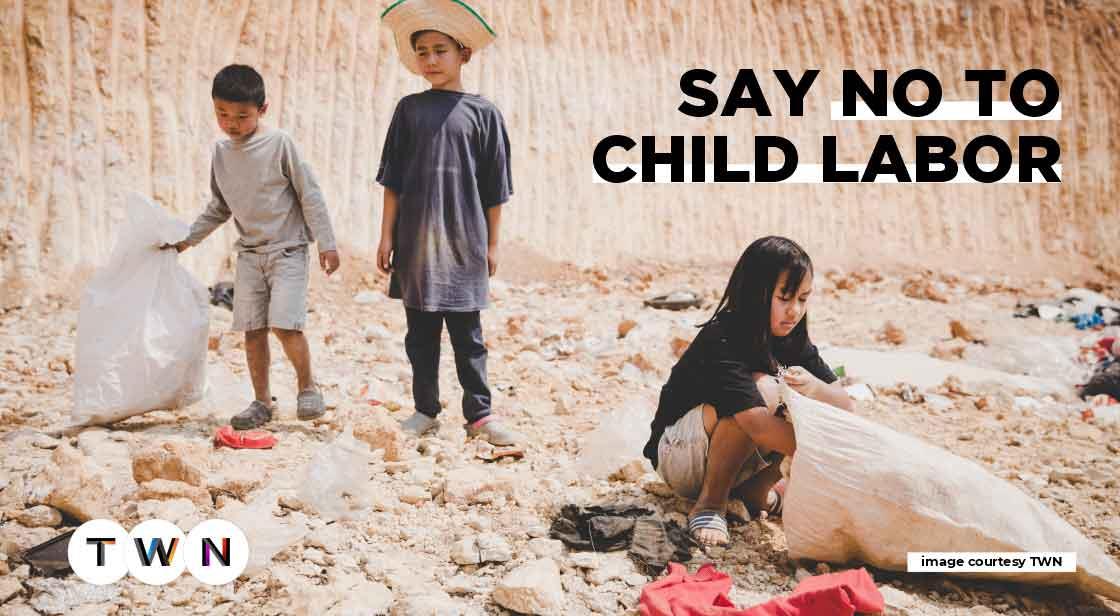World Day Against Child Labor – Act Before It is Too Late

Blog Post
In 2002, the International Labor Organization (ILO) established the World Day Against Child Labor to draw attention to the global scope of child labor and the actions and efforts required to eliminate it. Every year on June 12, government entities, employer associations, civil society, and millions of people worldwide come together to emphasize the sufferings of child laborers and what can be done to help them. This article will talk about anti-child labor day and how can you prevent child labor. #TWN
Back when I was a child, I saw many children of my age working in hotels and restaurants. I never knew that it was illegal to make a child work. As I grew up, I came to know that we celebrate national anti-child Labor Day in India, and that occasion made me think about how the lives of children are just tossed around and how they are deprived of basic rights. So, here we are, talking about World Day Against Child Labor or World Anti–Child Labor Day. This is our time to eliminate this curse and uplift the lives of the children who will be the future of this planet.
Every child has a right to be protected from evils like child labor.
On the day of World Day Against Child Labor (12th June), let’s spread awareness and make this world a place where our children feel safe.
World Day Against Child Labor: Background
In 2002, the International Labor Organization (ILO) established the World Day Against Child Labor to draw attention to the global scope of child labor and the actions and efforts required to eliminate it. Every year on June 12, government entities, employer associations, civil society, and millions of people worldwide come together to emphasize the sufferings of child laborers and what can be done to help them.
The Sustainable Development Goals (SDGs), which were endorsed by global leaders in 2015, include a wider global commitment to putting an end to child labor. Target 8.7 of the SDGs specifically calls on the global community to "take necessary steps in order to eradicate forced labor, end slavery, and human trafficking, and secure the prohibition and eradication of the worst types of child labor, including hiring and use of child soldiers, and end child labor in all its forms by 2025."
Child Labor – What is it?
Not every work done by children should be considered child labor and should be prohibited. Participation of children or adolescents in work that does not threaten their health or self-growth or interfere with their education is generally considered positive. This involves activities such as assisting their parents around the house, assisting in a family business, or earning pocket money after school and on weekends. These types of activities benefit children's development and the well-being of their families; they provide them with knowledge and skills, preparing them to be productive members of society as adults.
Child labor is defined as work done to harm and endanger a child by violating international and national law. It either denies children access to education or forces them to shoulder the dual load of education and work. Child labor to be eradicated is a subcategory of employment of children. It includes the following:
- All "unconditional" types of child labor, such as slavery or slavery-like practices, the use of a child for trafficking or illegal activities;
- Work performed by children under the minimum legal working age, as defined by the law legislation in line with international standards.
The most heinous forms of child labor involve children being sold into slavery, separated from their family members, exposed to life-threatening conditions and diseases, and/or left to fend for themselves on large city streets – often at a very young age. The definition of "child labor" depends on the child's age, the form and hours of work done, the circumstances under which it is performed, and the goals pursued by individual nations. The answer varies depending on the country and the sector within the country.
Prevalence of Child Labor
As per the International Labor Organization, global child labor has been gradually declining over the last two decades, but the COVID-19 pandemic jeopardizes this trend (ILO). As many as 60 million people are estimated to live in abject poverty this year alone, forcing families to send their children to work. According to a joint statement by the ILO and the United Nations Children's Fund, a one percent increase in poverty gives rise to at least a 0.7 percent increase in child labor.
While the rest of the world is dealing with COVID-19, data from India prove that children are still being exploited for child labor, despite the fact that the pandemic was followed by a lockdown. While the coronavirus global epidemic forced India's children out of schools (which were officially closed), many children were secretly migrated to factories and farms to work, exacerbating the country's child labor problem.
Causes of Child Labor
Child labor is a result of these reasons.
Economic & Structural Reasons
The most obvious cause for a child to work is to supplement the family's income. This is especially true for migrant communities, where parents may be jobless and homeless or only able to find the most menial and low-paying work. According to the theory of child labor as a family contribution, many children in developing countries work and support their families. According to studies conducted by Save the Children in Sweden, most children begin working on command, or at least in response to a request from their family, to contribute to the household income and/or assist with unpaid domestic chores. Because children often value themselves as members of the family unit, most will agree to help support the family, especially when family survival is at stake.
Self-Actualization Through Child Labor
According to this theory, even if poverty were not a determinant, some children would still want to participate in productive activities. Children working on family farms are an example of this, and it applies to both children who require part-time work in developed countries and kids in developing countries.
Child Labor As a Result of Family Dynamics
Other important factors in child labor include parental education and occupation. The higher the level of education of parents, particularly mothers, the less likely they are to allow their children to work. 23 Families with labor-intensive occupations, such as farmers, are more likely to have several children who begin to contribute economically at a young age, with labor income exceeding child-rearing costs. When a family's livelihood is jeopardized due to harvest screw-ups, mass unemployment, or the death of a breadwinner, it is common for the kids to enter the labor force.
Getting Away from Domestic Violence
Because of mistreatment, some children flee their homes in search of work. This is most common when a child leaves with a member of the wider family or when step-parents have abused the child.
Also Read: World Ocean Day 2022
Activities To Do on Anti Child Labor Day
On the day of anti-child labor, you can do the following things to stop child labor.
- Spread Awareness
- Make laws that are more stringent and can be effectively implemented.
- Make more children go to school.
- Stop people from hiring children to do the jobs of the adult.
- Support NGOs that work for the upliftment of children.
FAQ
What is the theme of World Day Against Child Labor 2022?
The theme this year is ‘Universal Social Protection to End Child Labor.’
Who established Anti Child Labor Day?
ILO (International Labor Organization) established Anti Child Labor Day in 2002.
Which area has the highest number of child laborers?
Sub-Saharan Africa has the highest number of child laborers according to UNICEF.
You May Like
EDITOR’S CHOICE












